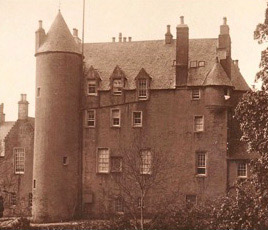WordPress database error: [Got error 28 from storage engine]
SELECT t.*, tt.*, tr.object_id FROM wp_terms AS t INNER JOIN wp_term_taxonomy AS tt ON tt.term_id = t.term_id INNER JOIN wp_term_relationships AS tr ON tr.term_taxonomy_id = tt.term_taxonomy_id WHERE tt.taxonomy IN ('category', 'post_tag', 'post_format') AND tr.object_id IN (2441, 5369, 38773) ORDER BY t.name ASC
Clan Boyle History

Kelburn Castle, North Ayrshire. The Boyles have held the lands of Kelburn since the 1100s, and have had a stronghold there, in one form or another, since the 13th century. The castle is still the seat of the Boyle chief.
The family ‘de Boyville’ came to Britain from the Norman town of Beauville near Caen in the invasion of 1066 and settled in various locations. In particular Wales and Cumberland. In 1124 King David granted Hugh de Morvile the lands of Cunningham and Largs. He subdivided these lands among his relatives and so the de Boyvilles received the lands of Kelburn.
David de Boivil appeared as a witness to a charter in 1164. The male line failed in 1196 and the property passed to the Lords of Galloway. When this line also failed to produce a male heir in 1234 the land passed to the crown. The family aided Alexander III in repelling the Vikings at the Battle of Largs in 1263 and the lands of Kelburn were returned to the family.
Henry de Boyville was the keeper of the castles of Dumfries, Wigtown and Kirkcudbright in 1291 and three de Boyvils signed King Edward’s Ragman Roll in 1296. Despite this apparent subjugation to English Rule the Boyle’s were still involved in the wars of independence, fighting at the Bannockburn in 1314 and the Battle of Sauchieburn for James III where Boyle sons were killed. They also fought for the Scots at Pinkie in 1547
After Sauchieburn the family lands were again forfeited, but they were restored when James IV re-established the monarchy. The family supported Mary, Queen of Scots and later, Charles I, a decision which did not improve the families good fortune. However, when John Boyle of Kelburn was elected as a Commissioner of Parliament in 1681 the Boyle fortune improved. During the 17th century the Boyle’s grew rich through shipping and shipbuilding. John’s son David, also became a Commissioner of Parliament and Privy Councillor and later became Lord Boyle of Kelburn in 1699, and later in 1703 Earl of Glasgow. He was a commissioners for the 1706 Act of Union and was appointed Lord High Commissioner to the General Assembly of the Church of Scotland. David was thought to have bribed Jacobite supporters to support the Act of Union. As a strong Hanoverian, he raised troops to fight against the Jacobites in 1715.
John Boyle, 3rd Earl of Glasgow had a distinguished military career. He was wounded at the Battle of Fontenoy in 1745 and at the Battle of Lauffeld in 1747. He was also Lord High Commissioner to the General Assembly for 9 years. The daughter of the first Earl, Lady Jean, married Sir James Campbell, who also fought at Fontenoy. Their son took over the Earldom of Campbell of Loudoun in 1782
Lady Augusta Boyle, the daughter of the fourth Earl, married Lord Frederick Fitz-clarence, son of William IV in 1891. John, Son of the fourth Earl was a naval officer who fought against the French near Gibraltar. in July 1807. Despite engaging the enemy bravely his ship was boarded by the French and he was taken prisoner. John never married and his younger brother James inherited the Earldom in 1843. Like his older brother he followed a naval career and was made Lord Lieutenant of Renfewshire. He married in 1821 but the couple had no children. When he died his half brother George Frederick Boyle became the sixth Earl the family fortunes took a sharp downturn.
George Boyle was strongly influenced by the Pre-Raphaelite movement and began a massive program of church building all over Scotland. The massive expense brought the estate into bankruptcy and by 1888 he was a million pounds in debt. His assets were put up for sale but Kelburn was saved by his cousin, later the seventh Earl. Sir David Boyle, 7th Earl, was also a naval officer and was created Baron Fairlie of Fairlie in 1897. He was also Governor of New Zealand from 1892 to 1897. The present chief of the name succeeded his father, in 1984 as tenth Earl of Glasgow and still lives at Kelburn Castle near Fairlie in Ayrshire.
Clan Boyle Posts








